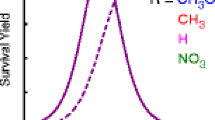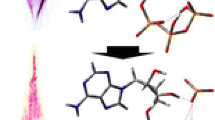Abstract
In this study, pentafluorobenzylpyridinium (F5-BnPy+), which has the highest dissociation energy among the reported benzylpyridinium thermometer ion, is proposed to characterize the internal energy distributions of ions activated by higher energy collisional dissociation (HCD) and ion-trap collision-induced dissociation (CID) during tandem mass spectrometry. The dissociation threshold energies of F5-BnPy+ was determined using quantum chemistry calculations at the CCSD(T)/6-311++G(d,p)//M06-2X-D3/6-311++G(d,p) level of theory, and the appearance energies for ion dissociation in HCD and ion-trap CID were estimated using Rice–Ramsperger–Kassel–Marcus theory. The main differences between HCD and ion-trap CID are the collision energies used and the timescales of collisional activation. For both HCD and ion-trap CID, the average internal energy of the ions increased with increasing collision energy. In contrast, the average value for the internal energy of the ions activated by ion-trap CID was lower than that of ions activated by HCD, probably because of the smaller collisional energy and longer activation time of the ion-trap CID experiments. The reported method will aid in the determination of the optimum tandem mass spectrometry parameters for the analysis of small molecules such as metabolites.
Graphical abstract








Similar content being viewed by others
Data availability
Data will be made available on reasonable request.
References
A. Revesz, H. Hever, A. Steckel, G. Schlosser, D. Szabo, K. Vekey, L. Drahos, Collision energies: optimization strategies for bottom-up proteomics. Mass Spectrom. Rev. 42, 1261–1299 (2023)
J.K. Diedrich, A.F. Pinto, J.R. Yates III., Energy dependence of HCD on peptide fragmentation: stepped collisional energy finds the sweet spot. J. Am. Soc. Mass Spectrom. 24, 1690–1699 (2013)
S.A. McLuckey, D.E. Goeringer, Slow heating methods in tandem mass spectrometry. J. Mass Spectrom. 32, 461–474 (1997)
J.V. Olsen, B. Macek, O. Lange, A. Makarov, S. Horning, M. Mann, Higher-energy C-trap dissociation (HCD) for peptide modification analysis. Nat. Methods 4, 709–712 (2007)
D. Szabo, G. Schlosser, K. Vekey, L. Drahos, A. Revesz, Collision energies on QTof and orbitrap instruments: how to make proteomics measurements comparable? J. Mass Spectrom. 56, e4693 (2021)
M.P. Jedrychowski, E.L. Huttlin, W. Haas, M.E. Sowa, R. Rad, S.P. Gygi, Evaluation of HCD- and CID-type fragmentation within their respective detection platforms for murine phosphoproteomics. Mol. Cell. Proteom. 10(M111), 009910 (2011)
G. Chen, R.G. Cooks, D.M. Bunk, M.J. Welch, J.R. Christie, Partitioning of kinetic energy to internal energy in the low energy collision-induced dissociations of proton-bound dimers of polypeptides. Int. J. Mass Spectrom. 185(186/187), 75–90 (1999)
V. Gabelica, M. Karas, E. De Pauw, Calibration of ion effective temperatures achieved by resonant activation in a quadrupole ion trap. Anal. Chem. 75, 5125–5159 (2003)
F. Ichou, A. Schwarzenberg, D. Lesage, S. Alves, C. Junot, X. Machuron-Mandard, J.C. Tabet, Comparison of the activation time effects and the internal energy distributions for the CID, PQD and HCD excitation modes. J. Mass Spectrom. 49, 498–508 (2014)
H.I. Kenttamaa, R.G. Cooks, Internal energy distributions acquired through collisional activation at low and high energies. Int. J. Mass Spectrom. Ion Proc. 64, 79–83 (1985)
V.H. Wysocki, H.I. Kenttamaa, R.G. Cooks, Internal energy distributions of isolated ions after activation by various methods. Int. J. Mass Spectrom. Ion Proc. 75, 181–208 (1987)
R.G. Cooks, T. Ast, B. Kralj, V. Kramer, D. Zigon, Internal energy distributions deposited in doubly and singly charged tungsten hexacarbonyl ions generated by charge stripping, electron impact, and charge exchange. J. Am. Soc. Mass Spectrom. 1, 16–27 (1990)
C. Collette, E. De Pauw, Calibration of the internal energy distribution of ions produced by electrospray. Rapid Commun. Mass Spectrom. 12, 165–170 (1998)
R. Rahrt, T. Auth, M. Demireva, P.B. Armentrout, K. Koszinowski, Benzhydrylpyridinium ions: a new class of thermometer ions for the characterization of electrospray-ionization mass spectrometers. Anal. Chem. 91, 11703–11711 (2019)
D. Asakawa, K. Saikusa, Characterization of the internal energy of ions produced by electrospray ionization using substituted benzyl ammonium thermometer ions. J. Am. Soc. Mass Spectrom. 33, 1548–1554 (2022)
D. Asakawa, Phenyl sulfate derivatives: new thermometer ions for characterization of internal energy of negative ions produced by electrospray ionization. J. Am. Soc. Mass Spectrom. 34, 435–440 (2023)
C. Collette, L. Drahos, E.D. De Pauw, K. Vekey, Comparison of the internal energy distributions of ions produced by different electrospray sources. Rapid Commun. Mass Spectrom. 12, 1673–1678 (1998)
V. Gabelica, E. De Pauw, Internal energy and fragmentation of ions produced in electrospray sources. Mass Spectrom. Rev. 24, 566–587 (2005)
D. Touboul, M.C. Jecklin, R. Zenobi, Ion internal energy distributions validate the charge residue model for small molecule ion formation by spray methods. Rapid Commun. Mass Spectrom. 22, 1062–1068 (2008)
K.V. Barylyuk, K. Chingin, R.M. Balabin, R. Zenobi, Fragmentation of benzylpyridinium “thermometer” ions and its effect on the accuracy of internal energy calibration. J. Am. Soc. Mass Spectrom. 21, 172–177 (2010)
D. Morsa, V. Gabelica, E. De Pauw, Fragmentation and isomerization due to field heating in traveling wave ion mobility spectrometry. J. Am. Soc. Mass Spectrom. 25, 1384–1393 (2014)
J.E. Carpenter, C.P. McNary, A. Furin, A.F. Sweeney, P.B. Armentrout, How hot are your ions really? A threshold collision-induced dissociation study of substituted benzylpyridinium “thermometer” ions. J. Am. Soc. Mass Spectrom. 28, 1876–1888 (2017)
M.T. Rodgers, K.M. Ervin, P.B. Armentrout, Statistical modeling of collision-induced dissociation thresholds. J. Chem. Phys. 106, 4499–4508 (1997)
D. Asakawa, H. Mizuno, E. Sugiyama, K. Todoroki, Fragmentation study of tryptophan-derived metabolites induced by electrospray ionization mass spectrometry for highly sensitive analysis. Analyst 146, 2292–2300 (2021)
D. Asakawa, E. Sugiyama, H. Mizuno, K. Todoroki, Study of substituted phenethylamine fragmentation induced by electrospray ionization mass spectrometry and its application for highly sensitive analysis of neurotransmitters in biological samples. J. Am. Soc. Mass Spectrom. 32, 2144–2152 (2021)
L.L. Lopez, P.R. Tiller, M.W. Senko, J.C. Schwartz, Automated strategies for obtaining standardized collisionally induced dissociation spectra on a benchtop ion trap mass spectrometer. Rapid Commun. Mass Spectrom. 13, 663–668 (1999)
M.J.T. Frisch, H.B. Schlegel, G.E. Scuseria, M.A. Robb, J.R. Cheeseman, G. Scalmani, V. Barone, G.A. Petersson, H. Nakatsuji, X. Li, M. Caricato, A.V. Marenich, J. Bloino, B.G. Janesko, R. Gomperts, B. Mennucci, H.P. Hratchian, J.V. Ortiz, A.F. Izmaylov, J.L. Sonnenberg, D. Williams-Young, F. Ding, F. Lipparini, F. Egidi, J. Goings, B. Peng, A. Petrone, T. Henderson, D. Ranasinghe, V.G. Zakrzewski, J. Gao, N. Rega, G. Zheng, W. Liang, M. Hada, M. Ehara, K. Toyota, R. Fukuda, J. Hasegawa, M. Ishida, T. Nakajima, Y. Honda, O. Kitao, H. Nakai, T. Vreven, K. Throssell, J.J.A. Montgomery, J.E. Peralta, F. Ogliaro, M.J. Bearpark, J.J. Heyd, E.N. Brothers, K.N. Kudin, V.N. Staroverov, T.A. Keith, R. Kobayashi, J. Normand, K. Raghavachari, A.P. Rendell, J.C. Burant, S.S. Iyengar, J. Tomasi, M. Cossi, J.M. Millam, M. Klene, C. Adamo, R. Cammi, J.W. Ochterski, R.L. Martin, K. Morokuma, O. Farkas, J.B. Foresman, Gaussian 16; Revision A.03 (Gaussian Inc, Wallingford, 2016)
Y. Zhao, D.G. Truhlar, The M06 suite of density functionals for main group thermochemistry, thermochemical kinetics, noncovalent interactions, excited states, and transition elements: two new functionals and systematic testing of four M06-class functionals and 12 other functionals. Theor. Chem. Acc. 120, 215–241 (2007)
S. Grimme, S. Ehrlich, L. Goerigk, Effect of the damping function in dispersion corrected density functional theory. J. Comput. Chem. 32, 1456–1465 (2011)
L. Goerigk, A. Hansen, C. Bauer, S. Ehrlich, A. Najibi, S. Grimme, A look at the density functional theory zoo with the advanced GMTKN55 database for general main group thermochemistry, kinetics and noncovalent interactions. Phys. Chem. Chem. Phys. 19, 32184–32215 (2017)
L. Drahos, K. Vekey, MassKinetics: a theoretical model of mass spectra incorporating physical processes, reaction kinetics and mathematical descriptions. J. Mass Spectrom. 36, 237–263 (2001)
E.L. Zins, D. Rondeau, P. Karoyan, C. Fosse, S. Rochut, C. Pepe, Investigations of the fragmentation pathways of benzylpyridinium ions under ESI/MS conditions. J. Mass Spectrom. 44, 1668–1675 (2009)
E.L. Zins, C. Pepe, D. Schroder, Energy-dependent dissociation of benzylpyridinium ions in an ion-trap mass spectrometer. J. Mass Spectrom. 45, 1253–1260 (2010)
F. Muntean, P.B. Armentrout, Guided ion beam study of collision-induced dissociation dynamics: integral and differential cross sections. J. Chem. Phys. 115, 1213–1228 (2001)
Acknowledgements
The authors acknowledge Prof. Naoki Asao of Shinshu University for the synthesis of CF3-BnPy+ and F5-BnPy+. The syntheses of CF3-BnPy+ and F5-BnPy+ were conducted at Shinshu University, supported by the Advanced Research Infrastructure for Materials and Nanotechnology in Japan (ARIM)” of the Ministry of Education, Culture, Sports, Science, and Technology (MEXT). Proposal Number: JPMXP1222SH-031. Molecular structure computations were performed at the Research Center for Computational Science in Okazaki, Japan (project nos. 23-IMS-C066 and 22-IMS-C074). This work was supported by JSPS KAKENHI (grant number 23H01996).
Author information
Authors and Affiliations
Corresponding author
Supplementary Information
Below is the link to the electronic supplementary material.
Rights and permissions
Springer Nature or its licensor (e.g. a society or other partner) holds exclusive rights to this article under a publishing agreement with the author(s) or other rightsholder(s); author self-archiving of the accepted manuscript version of this article is solely governed by the terms of such publishing agreement and applicable law.
About this article
Cite this article
Asakawa, D., Saikusa, K. Pentafluorobenzylpyridinium: new thermometer ion for characterizing the ions produced by collisional activation during tandem mass spectrometry. ANAL. SCI. 39, 2031–2039 (2023). https://doi.org/10.1007/s44211-023-00419-0
Received:
Accepted:
Published:
Issue Date:
DOI: https://doi.org/10.1007/s44211-023-00419-0




